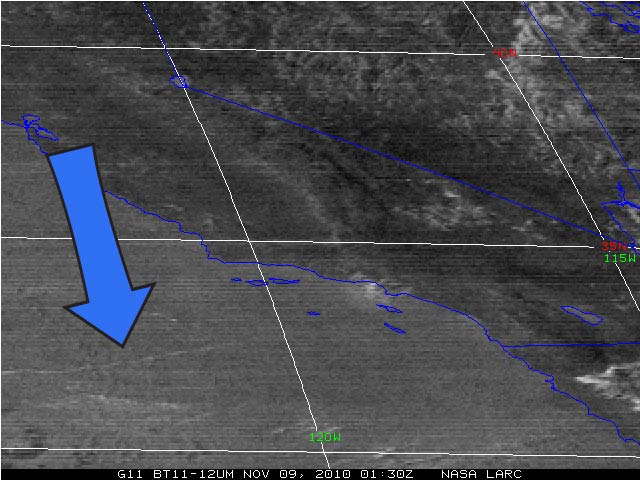Infamous Contrail (aka the 'Mystery Missile') Spotted in Satellite Image

The 'mystery' contrail is visible as a horizontal white streak in the middle of the lower left quadrant of this image, captured by the Geostationary Operational Environmental Satellite 11. The satellite is a partnership between NASA Goddard Space Flight Center and the National Oceanographic and Atmospheric Administration (NOAA).
When an impressive contrail was spotted off the California coast last week, it sparked widespread reports of a mystery missile launch in the area – a theory the Pentagon squashed after initial investigations. But, the odd contrail fooled more than the public and media, and was even seen from space.
After watching footage of the Nov. 8 contrail, Patrick Minnis, a contrail expert in the Science Directorate at NASA's Langley Research Center in Hampton, Va., assumed it came from a missile, as many others did.
He even said so in response to a phone call from a reporter. [7 Things That Make Great Space Hoaxes]
"She responded with links to two different blogs that compared it to older aircraft contrail pictures, and indicated that the blog authors thought it was an aircraft contrail," Minnis said of the reporter. "I had not really thought about that aspect previously and, at first glance, the video showed what looked like a missile launch. Once the idea that it was an aircraft contrail entered my head, I had to pay closer attention, because aircraft contrails are part of my job description."
Later, he learned that fellow NASA scientist Doug Spangenberg had pieced together a photo of the mystery contrail from space after sifting through weather satellite images.
Missile vs. contrail
Get the Space.com Newsletter
Breaking space news, the latest updates on rocket launches, skywatching events and more!
Minnis typically studies contrails in order to determine their effect on Earth's climate. He and other scientists have discovered that airplane contrails create cirrus clouds on days they wouldn't usually exist.
According to his calculations, the cirrus-cloud cover over the United States is increasing by 1 percent each decade as a result, effectively contributing to global warming by blocking the release of heat from the planet.
Minnis used that experience to examine the California contrail, which had been seen near Catalina Island, off the coast of Los Angeles.
"It appeared to be between two high clouds, one in foreground and one in the background," Minnis said. "I would have expected that it was at the same level or above the high clouds, so it should have been obscured more by the cloud in the background. Thus, I concluded again that it was a missile."
Satellite photos tell the tale
Minnis then tried a different approach, this time with the Spangenberg, who also works at Langley Research Center. Spangenberg had sequenced imagery from the Geostationary Operational Environmental Satellite 11 (GOES-11) that showed a persistent contrail that could match the mystery contrail.
With the help of other Langley researchers, Minnis also learned that on Nov. 9, conditions were "ripe" for persistent contrails over the Pacific west of Los Angeles, but that the contrails would only survive for a short time closer to the coast.
"As it turns out, the high clouds seen in the background of the video were actually behind the contrail because the plane had flown north of the clouds, and changed course to the northeast, so that the clouds were behind the contrail as viewed from Catalina Island," Minnis said. "All of that information changed my mind."
Based on his research, Minnis said he can't definitively prove that the contrail came from an airplane. But, it is the "most likely" scenario given the data.
"Later, while viewing some blogs, I found that the contrail corresponded remarkably well with flight AWE808, which flew from Hawaii to Phoenix; it showed the change in course to the northeast at the same location, further confirming my conclusion."
After an initial investigation, the military quashed the "mystery missile" scenario, with many other experts also suggesting the contrail was caused by a run-of-the-mill jet aircraft.
"While there is nothing at this time that leads the Department of Defense to believe this is a missile launch, the department and other U.S. government agencies with expertise in aviation and space continue to look into the condensation trail (contrail) seen and reported off the coast of southern California on Monday evening," DoD spokesman Col. Dave Lapan said last week.
Join our Space Forums to keep talking space on the latest missions, night sky and more! And if you have a news tip, correction or comment, let us know at: community@space.com.

Space.com is the premier source of space exploration, innovation and astronomy news, chronicling (and celebrating) humanity's ongoing expansion across the final frontier. Originally founded in 1999, Space.com is, and always has been, the passion of writers and editors who are space fans and also trained journalists. Our current news team consists of Editor-in-Chief Tariq Malik; Editor Hanneke Weitering, Senior Space Writer Mike Wall; Senior Writer Meghan Bartels; Senior Writer Chelsea Gohd, Senior Writer Tereza Pultarova and Staff Writer Alexander Cox, focusing on e-commerce. Senior Producer Steve Spaleta oversees our space videos, with Diana Whitcroft as our Social Media Editor.









